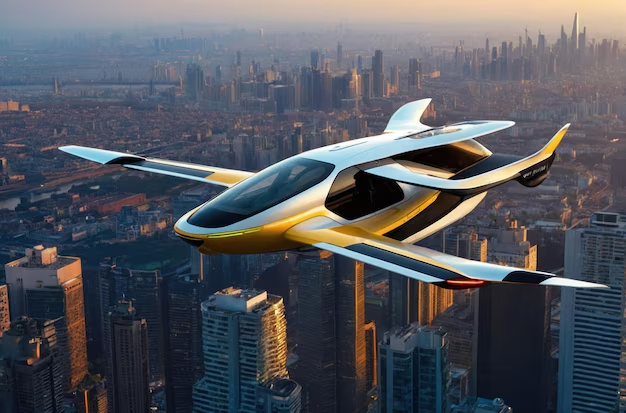Table of Contents
ToggleThe Air Taxi Phenomenon
Imagine whisking above the city skyline, over the jammed streets, and getting to your destination in a fraction of the time. It is not a scene from some sci-fi movie but, in fact, the reality one will be faced with flying taxis—a new mobility solution that will make city traveling much more efficient. In this blog, we will delve into the emerging world of air taxis, discussing the latest regulatory developments, leading companies, and technologies forming this futuristic way of transportation. By this era coming up, we will be able to work in the city and live countryside and that would be an amazing thing to happen. Imagine a world, in which we used to have only bicycles to travel, having an air taxi will be a five times faster event to reach to our designations. Sounds impossible but yes, it’s happening and we all are looking forward to it. Few reports suggests that by 2030, the market will be having at least 5 leading companies in the same field. The time to destination from home will definitely gonna decrease. Though the steps taken to reach via any eVTOL will be same like flying in an airplane but then it would save a hell lot of time and who won’t like to reach before time and have a sip of coffee before your tedious day starts.

Certifying the Future: FAA and EASA’s Role
Key to this revolution are the Federal Aviation Administration and European Union Aviation Safety Agency, each of which has issued new certification criteria for the development of air taxis. These will focus on issues such as noise control, safety in urban environments, and passenger security. These regulators being of a progressive stance provides the green light to companies that are breaking into the air taxi market, heralding a new era in certified urban air travel. According to FAA, flying is the safest mode of transportation as per the records and the same is expected from this new era of eVTOLs coming up.
From Start-Up To Sky: South Korea’s Helicopter Taxi Service
South Korea: A revolutionary start-up has now turned heads with its helicopter taxi service, which might set the stage for other air-taxi services around the world. This service not only defines novel urban transportation but is also an assertion of scale and the potential profitability of air taxi operations. South Korea, with an independent opinion of aerial mobility, serves as a case study to other countries and answers their ambition to relieve urban confluences and introduce new dimensions into their infrastructure. The aviation start-up company has recently launched Helicopter Taxi Service from Seoul’s Gangnam district to the airport which will cut the travel time from nearly two hours to 20 minutes.
Joby’s Bold Move: Towards Pilotless Air Taxis
Joby Aviation has recently acquired an autonomous flight technology company, and its implications for the air taxi industry could be nothing less than revolutionary. This latest strategic acquisition suggests that someday in the future, air taxis will take off without pilots—rather, guided by advanced AI in negotiating their way across urban geographies. The push toward autonomy will not only affect safety but also drastically cut back on operational costs. The design of the vehicle by the company has six electric motors and takes off and lands vertically giving a feeling of a SUV. As per the latest news, Joby is all set to start its service in Dubai by early 2026.
Pioneering Sustainability: The EVTOL Advantage
At the centre of this air taxi revolution, electric vertical take-off and landing (eVTOL) aircraft offer a sustainable option for traditional aviation. These crafts can be quiet and greener than their helicopter predecessors, as well as designed for the urban environment. With that laser focus on zero-emission flight, eVTOLs are setting up a cleaner, greener way into the future of urban mobility.
The Sky’s the Limit: The Economics of Air Taxis
As technology and the right regulations fall into place for air taxis to take off, the biggest factor in their wide adoption continues to be the economic model behind them. Operators need to balance the cost of advanced technology and infrastructure against low-enough pricing to attract a wide user base. Most important, however, this depends on public acceptance and seamlessly intermodal transportation. So, each eVTOL passenger might pay, according to the company’s own executives, to its own investor materials and a NASA study, from $2.25 per mile to as much as $11 per mile, depending on several unpredictable factors. Morgan Stanley acknowledged that for one company to build both an airline and an aircraft manufacturing business simultaneously “is challenging and extremely capital intensive.”
Regulatory Horizons and Public Trust
In case the air taxis are to transform the skyline, the turning points are acceptance and trust by the public through the work of regulatory bodies. The mentioned ones are regarding safety standards, privacy concerns, and noise regulation, which are assured to secure a process of accepting the air taxis. Public acceptance will be characterized by a harmonious development of air taxis into existing airspaces through transparent communication and rigorous testing in collaboration with companies and regulators.
Conclusion
Air taxis are expected to change the game in urban mobility from sustainable and efficient points of view, making provisions for unmatched convenience. As the industry overcomes technical and regulatory obstacles, dreams of zipping above traffic in a quiet, eco-friendly air taxi could be close to becoming a reality. It spells exciting prospects for city dwellers, environmental enthusiasts, and an overall overhaul of the urban landscape.

